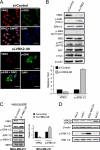VRK2 inhibits mitogen-activated protein kinase signaling and inversely correlates with ErbB2 in human breast cancer
- PMID: 20679487
- PMCID: PMC2950518
- DOI: 10.1128/MCB.01581-09
VRK2 inhibits mitogen-activated protein kinase signaling and inversely correlates with ErbB2 in human breast cancer
Abstract
The epidermal growth factor (EGF)-ErbB-mitogen-activated protein kinase (MAPK) transcription signaling pathway is altered in many types of carcinomas, and this pathway can be regulated by new protein-protein interactions. Vaccinia-related kinase (VRK) proteins are Ser-Thr kinases that regulate several signal transduction pathways. In this work, we study the effect of VRK2 on MAPK signaling using breast cancer as a model. High levels of VRK2 inhibit EGF and ErbB2 activation of transcription by the serum response element (SRE). This effect is also detected in response to H-Ras(G12V) or B-Raf(V600E) oncogenes and is accompanied by a reduction in phosphorylated extracellular signal-regulated kinase (ERK) levels, p90RSK levels, and SRE-dependent transcription. Furthermore, VRK2 knockdown has the opposite effect, increasing the transcriptional response to stimulation with EGF and leading to increased levels of ERK phosphorylation. The molecular mechanism lies between MAPK/ERK kinase (MEK) and ERK, since MEK remains phosphorylated while ERK phosphorylation is blocked by VRK2A. This inhibition of the ERK signaling pathway is a consequence of a direct protein-protein interaction between VRK2A, MEK, and kinase suppressor of Ras 1 (KSR1). Identification of new correlations in human cancer can lead to a better understanding of the biology of individual tumors. ErbB2 and VRK2 protein levels were inversely correlated in 136 cases of human breast carcinoma. In ErbB2(+) tumors, there is a significant reduction in the VRK2 level, suggesting a role for VRK2A in ErbB2-MAPK signaling. Thus, VRK2 downregulation in carcinomas permits signal transmission through the MEK-ERK pathway without affecting AKT signaling, causing a signal imbalance among pathways that contributes to the phenotype of breast cancer.
Figures








Similar articles
-
Ran is a potential therapeutic target for cancer cells with molecular changes associated with activation of the PI3K/Akt/mTORC1 and Ras/MEK/ERK pathways.Clin Cancer Res. 2012 Jan 15;18(2):380-91. doi: 10.1158/1078-0432.CCR-11-2035. Epub 2011 Nov 16. Clin Cancer Res. 2012. PMID: 22090358 Free PMC article.
-
Tumor suppressor PTEN inhibits integrin- and growth factor-mediated mitogen-activated protein (MAP) kinase signaling pathways.J Cell Biol. 1998 Nov 30;143(5):1375-83. doi: 10.1083/jcb.143.5.1375. J Cell Biol. 1998. PMID: 9832564 Free PMC article.
-
Blockade of epidermal growth factor- or heregulin-dependent ErbB2 activation with the anti-ErbB2 monoclonal antibody 2C4 has divergent downstream signaling and growth effects.Cancer Res. 2004 Apr 1;64(7):2601-9. doi: 10.1158/0008-5472.can-03-3106. Cancer Res. 2004. PMID: 15059917
-
Role of Ras and Mapks in TGFbeta signaling.Cytokine Growth Factor Rev. 2000 Mar-Jun;11(1-2):23-35. doi: 10.1016/s1359-6101(99)00026-x. Cytokine Growth Factor Rev. 2000. PMID: 10708950 Review.
-
VRK2 kinase pathogenic pathways in cancer and neurological diseases.Biochim Biophys Acta Mol Cell Res. 2025 Jun;1872(5):119949. doi: 10.1016/j.bbamcr.2025.119949. Epub 2025 Apr 3. Biochim Biophys Acta Mol Cell Res. 2025. PMID: 40187568 Review.
Cited by
-
Nuclear functions regulated by the VRK1 kinase.Nucleus. 2024 Dec;15(1):2353249. doi: 10.1080/19491034.2024.2353249. Epub 2024 May 16. Nucleus. 2024. PMID: 38753965 Free PMC article. Review.
-
Predictive value of vrk 1 and 2 for rectal adenocarcinoma response to neoadjuvant chemoradiation therapy: a retrospective observational cohort study.BMC Cancer. 2016 Jul 25;16:519. doi: 10.1186/s12885-016-2574-9. BMC Cancer. 2016. PMID: 27456229 Free PMC article.
-
HPV-related methylation-based reclassification and risk stratification of cervical cancer.Mol Oncol. 2020 Sep;14(9):2124-2141. doi: 10.1002/1878-0261.12709. Epub 2020 Jun 2. Mol Oncol. 2020. PMID: 32408396 Free PMC article.
-
A whole-genome RNA interference screen for human cell factors affecting myxoma virus replication.J Virol. 2013 Apr;87(8):4623-41. doi: 10.1128/JVI.02617-12. Epub 2013 Feb 13. J Virol. 2013. PMID: 23408614 Free PMC article.
-
Trans-ethnic meta-analysis of genome-wide association studies for Hirschsprung disease.Hum Mol Genet. 2016 Dec 1;25(23):5265-5275. doi: 10.1093/hmg/ddw333. Hum Mol Genet. 2016. PMID: 27702942 Free PMC article.
References
-
- Albanese, C., J. Johnson, G. Watanabe, N. Eklund, D. Vu, A. Arnold, and R. G. Pestell. 1995. Transforming p21ras mutants and c-Ets-2 activate the cyclin D1 promoter through distinguishable regions. J. Biol. Chem. 270:23589-23597. - PubMed
-
- Amado, R. G., M. Wolf, M. Peeters, E. Van Cutsem, S. Siena, D. J. Freeman, T. Juan, R. Sikorski, S. Suggs, R. Radinsky, S. D. Patterson, and D. D. Chang. 2008. Wild-type KRAS is required for panitumumab efficacy in patients with metastatic colorectal cancer. J. Clin. Oncol. 26:1626-1634. - PubMed
-
- Benachenhou, N., S. Guiral, I. Gorska-Flipot, D. Labuda, and D. Sinnett. 1998. High resolution deletion mapping reveals frequent allelic losses at the DNA mismatch repair loci hMLH1 and hMSH3 in non-small cell lung cancer. Int. J. Cancer 77:173-180. - PubMed
-
- Blanco, S., L. Klimcakova, F. M. Vega, and P. A. Lazo. 2006. The subcellular localization of vaccinia-related kinase-2 (VRK2) isoforms determines their different effect on p53 stability in tumour cell lines. FEBS J. 273:2487-2504. - PubMed
-
- Blanco, S., and P. A. Lazo. 2009. Vaccinia-related kinase-2. UCSD-Nature Molecule Page doi:10.1038/mp.a000905.01. - DOI
Publication types
MeSH terms
Substances
LinkOut - more resources
Full Text Sources
Medical
Molecular Biology Databases
Research Materials
Miscellaneous
